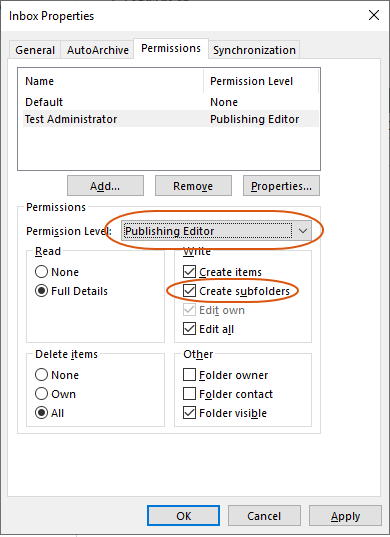Configure a Mailbox Monitor service workflow
The Mailbox Monitor service workflow monitors email activity in one or more mailboxes. The service workflow defines which mailboxes are monitored, and how often the mailboxes are checked for emails. You can create service workflows in WorkZone Configurator.
Create a Mailbox monitor service workflow
- Open WorkZone Configurator.
- Go to Process > Service workflows.
- In the bottom right corner of the page, click
 Create.
Create. - Select the Mailbox monitoring or the Cloud Mailbox monitoring service workflow depending on whether your organization uses Exchange On-Premises or Exchange Online.
- Enter a name and description, and then click Create.
See Service workflows in the WorkZone Configurator Administrator Guide.
Configure a Mailbox Monitor service workflow in WorkZone Configurator
Prerequisite:
- The Exchange user must have the Delegate access with Editor permission on the inboxes that you want to monitor. See the Configure a Mailbox Monitor service workflow parameter. In Outlook, log on to each of the Exchange mailboxes that you want to monitor, and go to File > Account Settings > Delegate access and add the Exchange user as a delegate.
-
The Exchange user must have publishing editor rights. To verify that the permissions are correct, right-click the inbox and click Properties > Permission tab. Verify that the Exchange user has the permission level Publishing Editor and that the Create subfolders check box is selected.

- Open WorkZone Configurator.
- Click Process > Service workflows.
- Point to the Mailbox monitoring service workflow that you just created, and click
Edit parameters to configure the service workflow.
- Enter values for the parameters.
If you want the service workflow to monitor multiple mailboxes, pay attention to the configuration of the following parameters:
The Exchange configurations depend on whether your organization uses Exchange On-Premises or Exchange Online.
On-premises
| Name | Description | Sample values |
|---|---|---|
| ExchangeUrl | The URL of the Exchange web service. | https://<host>/EWS/Exchange.asmx. |
| ExchangeDomain | The domain for the Exchange user. | |
| ExchangeUser | Login for the Exchange user. This user must have access to the Exchange mailbox. The user must be a WorkZone user and the name must be in uppercase. | The user that you have set up as the smarttask sender during configuration of WorkZone Process. |
| ExchangePassword | The password for the Exchange user. |
Online
| Name | Description | Sample values |
|---|---|---|
| ExchangeOAuthClientId | The OAuth2 Client ID that is used to access the mailbox in Exchange Online. | |
| ExchangeOAuthTenantId | ExchangeOAuthTenantId: The OAuth2 Tenant ID used to access the mailbox in Exchange Online. | |
| ExchangePassword |
The password of the Exchange user that is used in the public client flow also named Resource Owner Password Credentials (ROPC ) flow. It is recommended to choose between setting this parameter and the ExchangeOAuthClientSecret parameter. If you fill in both, the ExchangeOAuthClientSecret parameter will be prioritized over the ExchangePassword parameter. |
|
| ExchangeOAuthClientSecret |
The OAuth2 Client secret used to access the mailbox in Exchange Online. If set, the client credentials flow is used. It is recommended to choose between setting this parameter and the ExchangePassword parameter. If you fill in both, the ExchangeOAuthClientSecret parameter will have priority over the ExchangePassword parameter. |
Note: The public client flow (ROPC) with the ExchangePassword parameter is less complex to set up, but it allows logging in without multi-factor authentication to the application in the AAD, so it may decrease the security level for organizations that use multi-factor authentication to AAD.
The client credential flow with ExchangeOAuthClientSecret parameter is better suited for service accounts such as the service accounts that the Mailbox monitoring workflow monitors, but is complex to set up correctly because it requires a second application registration in the AAD (Azure Active Directory) with the access scoped only to a group of service users.
Other parameters
The parameters below are common to both the Mailbox monitoring and the Cloud Mailbox monitoring service workflows
